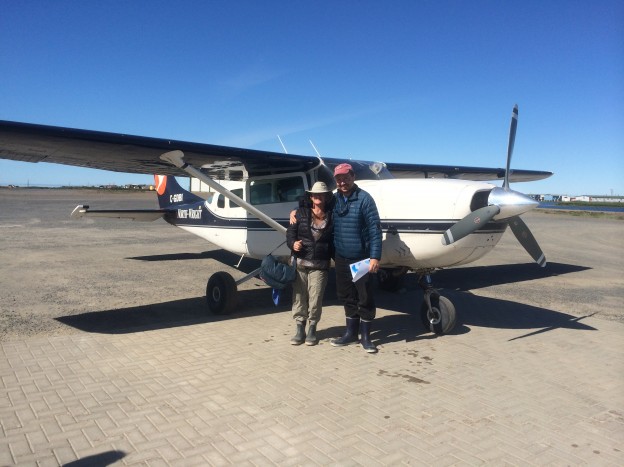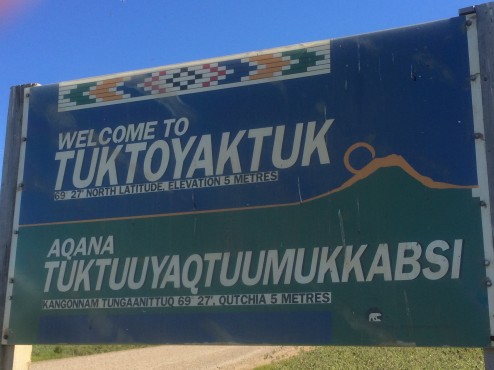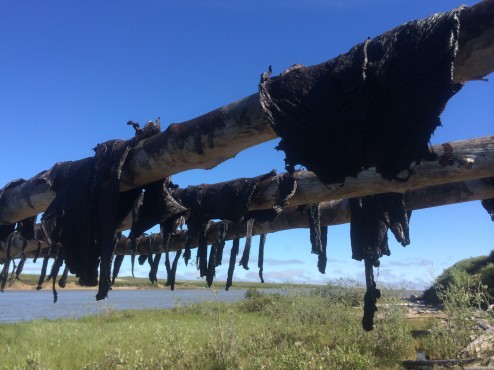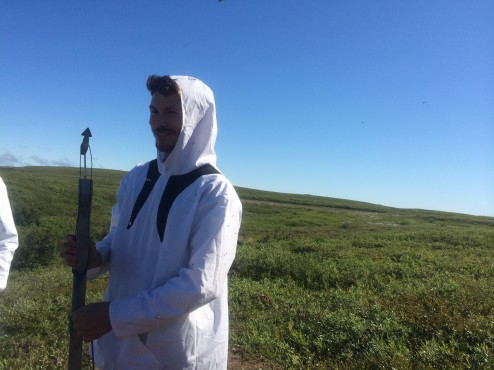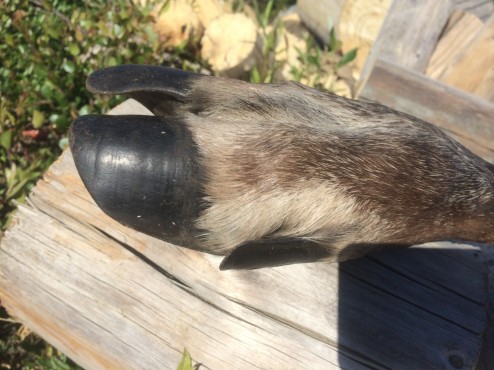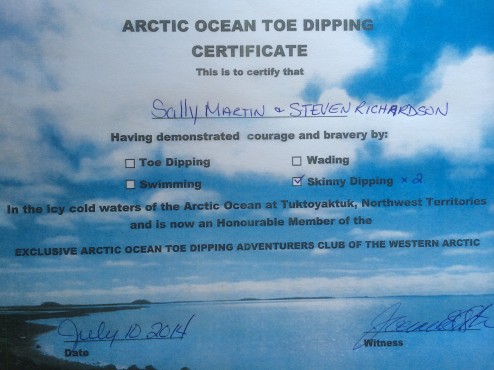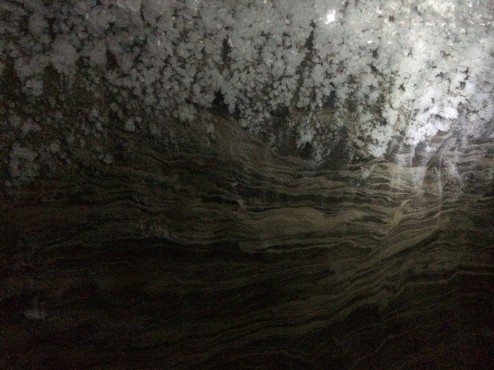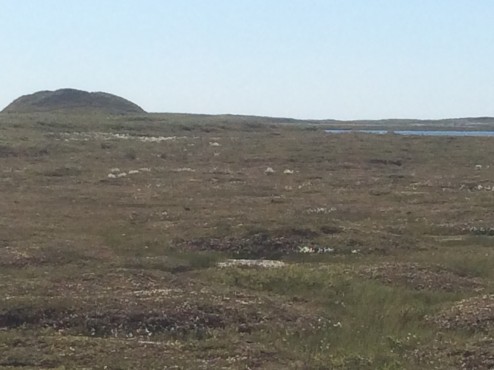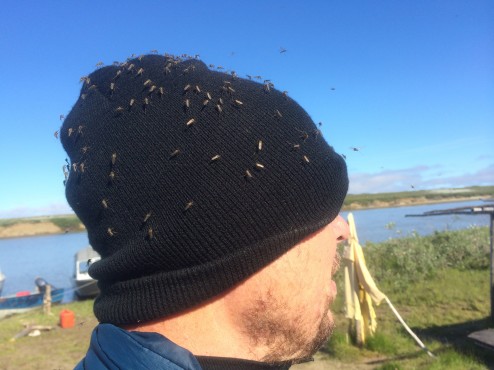You must cross two rivers, the Peel and the Arctic Red by ferry, and take a boat or flight from Inuvik, out the Mackenzie Delta to reach the far northern town of Tuktoyaktuk on the Arctic Ocean in the Northwest Territories. The land is predominantly settlement lands that have been the homes and hunting grounds of the Gwiich’n and Inuvialuit First Nation people for thousands of years. These two rivers (crossed by ferry in summer) freeze up and become the only passable road in winter. No passage to the far north is possible, except by air, during “Break Up” (during late spring as the ice on the river melts too much to carry vehicle weight and there is too much ice to allow the ferries on the river), and during “Freeze Up” (before the ice is thick enough to support vehicles.
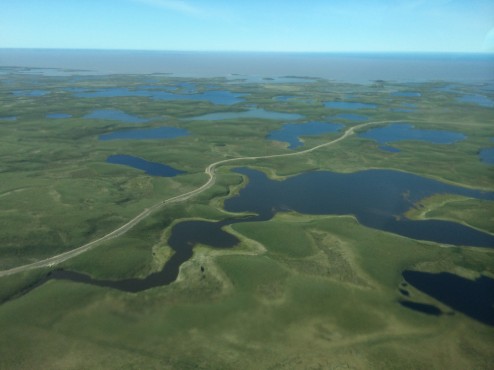 We took a boat trip from Inuvik to Tuk as there is no road in summer…until completion of a highly controversial, “year round road” in 2016 (see photo above over the tundra at the Arctic Ocean, from our air flight out of Tuk). Other than serving gas/oil interests who want a deep port at Tuk for oil exportation to Asia, and the Canadian Government who wants a road that goes all the way to SOME Northern Canadian border, only 300 people live in Tuk, 8 feet above tideline, to enjoy it. Many predict it will be the longest pier in the world, as Tuk is slated to be underwater within 30 years from the effects of global warming. While Canada and the NT government are laying fiber optic cable between Inuvik and Yellowknife (the NT capital where 90% of Territory residents live), seems a logical time to build a road that would be well used, no one seems to be discussing a road from the capital to the North. The only access now is by air, the Mckenzie River, or by roads so convoluted that little is shipped and nobody travels by road from the capital. Hmmm….politics.
We took a boat trip from Inuvik to Tuk as there is no road in summer…until completion of a highly controversial, “year round road” in 2016 (see photo above over the tundra at the Arctic Ocean, from our air flight out of Tuk). Other than serving gas/oil interests who want a deep port at Tuk for oil exportation to Asia, and the Canadian Government who wants a road that goes all the way to SOME Northern Canadian border, only 300 people live in Tuk, 8 feet above tideline, to enjoy it. Many predict it will be the longest pier in the world, as Tuk is slated to be underwater within 30 years from the effects of global warming. While Canada and the NT government are laying fiber optic cable between Inuvik and Yellowknife (the NT capital where 90% of Territory residents live), seems a logical time to build a road that would be well used, no one seems to be discussing a road from the capital to the North. The only access now is by air, the Mckenzie River, or by roads so convoluted that little is shipped and nobody travels by road from the capital. Hmmm….politics.
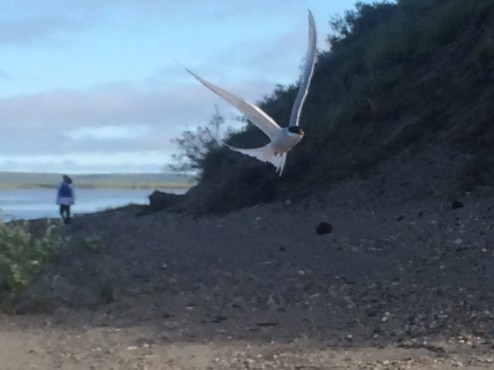 On the way to Tuk by boat, we not only enjoyed many of the byways of the second largest delta in Canada, at a pee stop I finally got to see Arctic Tern up close, as I stumbled into a nesting area and got dive bombed until I left the area. They are very aggressive and agile birds and we enjoyed watching them hover and dive as they hunted.
On the way to Tuk by boat, we not only enjoyed many of the byways of the second largest delta in Canada, at a pee stop I finally got to see Arctic Tern up close, as I stumbled into a nesting area and got dive bombed until I left the area. They are very aggressive and agile birds and we enjoyed watching them hover and dive as they hunted.
At our guide’s Aunt Clara’s whaling camp in the bush, we arrived after her family had caught one of the three beluga whales they hunt each year. The harpoon seems too primitive to snare a 13 foot long beluga whale but it is effective as we saw another small boat bringing one into another whale camp nearby.
We ate Muktuk (blubber and skin, eaten raw or boiled), dried whale meat (above), herring, and caribou (from one who wandered into camp the week before). The entire extended family lives off these meats during the winter.
We couldn’t resist naked immersion in the Arctic Ocean; there is no need to torture you with a naked picture as we got a certificate for proof!
We visited the community Ice House by climbing 30 feet down a frozen slippery ladder into the permafrost (mud frozen solid for more than two years continuously) into a community meat locker still used for storing large kills year round. So beautiful, the layered permafrost covered with oddly square ice crystals.
We also hiked up a “Pingo” which is a tundra covered tall mound. It is filled with permafrost and created when a lake empties out suddenly with a breach, allowing the outside to freeze solid like a donut around unfrozen water which can only expand upward as it freezes. There are more than 1300 of these in the Western Arctic and we could see new ones forming as we flew over the Arctic tundra.
We really appreciated the warmth and hospitality of this Inuit family. They are so tough, and so family oriented, creative, and quick to laugh. It would require all those things to survive a month trying to work in the bush with these voracious mosquitoes. Here’s a scary picture of Steven’s toque covered with about 150 mosquitoes.

